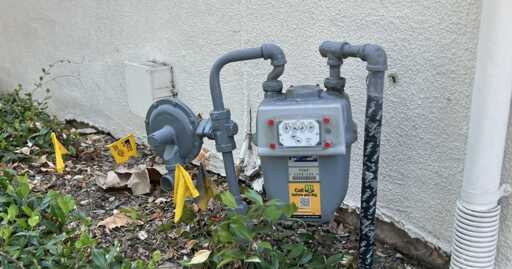California has the 2nd highest electric rates in the country. Not sure why they want to fuck poor people even more. I’m for getting things clean, but this is treating a symptom and not the disease.
How is this fucking poor people? They’re providing them free infrastructure upgrades.
I am in the process of electrifying and it saves me money. The electrical options are much more efficient and gas is expensive.
Don’t know if you’re in California and poor, or not. I am. Gas is way cheaper. Don’t misunderstand me, I think things have to move in this direction, but unless it comes with a big subsidy (something along the lines of the heat pumps mentioned in the article), make no mistake, it’s fucking poor people.
How much cheaper is gas? In the UK gas is 1/3 the cost of electricity per mw, but gas boilers are less than 1/3 as efficient so heat pumps are still cheaper to run.
Right now in California natural gas is about $14-15 per thousand cubic feet (yeah it’s a stupid unit), which is about 1 million BTUs (another stupid unit of energy). That translates to about 290 kWh.
The average residential price of electricity in California is about 30 cents per kWh. So the same amount of energy in electricity would be about $87, about 5.8 times as expensive as gas per unit energy.
If a heat pump is 4 times as efficient at heating than a gas furnace, then we’re still looking at higher heating costs for heating a home.
And things like stoves and hot water heaters tend not to be as efficient as heat pumps, so you’re still looking at a 4-6x cost difference from electrification on those.
Yeesh! It’s crazy that gas is so much cheaper in a place with such abundant sunlight- any idea why? Are there lopsided grants/funding?
Natural gas is abundant and cheap in North America, and transporting gas overseas has always been inefficient and expensive, so each continent tends to have their own price for natural gas.
Electricity is expensive in California in large part because the transmission lines cause devastating wildfires, so the rates now includes the cost of preventing fires by continuously trimming trees and other vegetation near power lines, and paying off past liability for billions of damage in previous fires.
Everyone says the transmission lines cause devastating wildfires but that’s the proximate cause. It’s like if we went to a gas station and there was an enormous leak with a giant pool of gasoline filling the parking lot and then we blamed a lady wearing a wool sweater for giving off the spark that starts the whole thing ablaze.
The problem with wildfires in California is twofold: 1) not enough controlled burning (due to underfunding and lack of staff) and 2) too many homes built in the highest risk areas.
I think part of this issue is the California government’s boneheaded fight with insurance companies which seeks to prevent them from appropriately pricing the risk for home insurance. One of the most valuable things insurance companies (as hated as they are) do for society is develop highly sophisticated risk models for wildfire and flood damage. When allowed to, they incorporate these models into the premiums they charge for home insurance in different areas. This would ordinarily make it extremely expensive to insure a home in the highest risk areas, creating a market disincentive to build there, but Californians insist on fighting this (shooting the messenger) through the political system.
California is great at putting it’s horse before its cart
This sounds great but can the 70 year old grid handle the electrical load? Are they adding incentives for free or reduced solar? Is it practical AT ALL?
California has a lot of solar already, but the incentives are not great right now, and they have added battery storage too
Add to it that if your power doesn’t come from renewable sources, it’s worse for the environment to switch to electric appliances. Just. This sounds like people really meaning well…
Wild claim to make without backing it up with anything. Additionally, with no grids being fully non-renewable at this point, and everyone trending towards renewables for economic reasons, this is just flat out wrong
Yeah, this is a case of me assuming things are common knowledge which I really had no business assuming.
Here’s the best source to use, the CEC’s data reports. FWIW, cali still generates 43% of their power using natural gas - and has added a truly pitiful amount of renewables over the past 5 years. While the end-goal here is absolutely the way to go - induction stoves and heat pumps are undeniably more efficient than their gas alternatives (often 400%+ for heat pumps) - any money here would be much better spent on updating the electrical grid to the point that the kind of losses which plague California’s truly neglected power infrastructure are addressed.
If the natural gas power plants were all CCGT running desulfurized gas on decent transmission infrastructure, this would absolutely be a positive move. But right now, your substation is running a 1970s dry-loop stepdown transformer on the transmission lines (and every poor area is running at least one, thanks PG&E) and that alone is eating any potential energy savings this could achieve. Plus, adding load to this already overtaxed system (anyone else remember the summer brownouts?) before its updated is just shifting the responsibility for the environment onto the consumers, again, pretty blatantly greenwashing the whole broken system. And also it’ll force the decrepit standby gas powerplants back into more regular operation to keep up with the increasing power demands. (This is just ignoring the greenhouse emissions present in the supply and disposal chain for which I cannot find concrete numbers)
Right now this is a pilot project, and it’s investigating strategies to get people to switch their appliances and the feasability/impact of neighborhood decarbonization. That’s great, but it’s spectacularly not the problem that actually needs to be addressed, and just taking the funding for their dumbass “block party” and putting it towards transmission infrastructure would have a larger impact than all three blocks switching from gas could ever have. The emissions from the already failing infrastructure are far more critical, and are not being addressed, and I can’t understand why nobody is talking about this more. Assuming the best case, that all the current trends hold but power consumption plateaus (and you can check the math for yourself if you want), california is going to miss their 2045 deadline by ~10 years. Switching to an induction stovetop (which nobody in a poor neighborhood is going to be able to afford anyways) or a heat-pump (which many low-income multi-units will require structural updates to be able to install the new equipment) are good things to encourage, but it’s not going to actually help anything until we youtube some PG&E executives and overhaul the system.
(Uhhh sorry, got a little side tracked there. Gas doesn’t have trasnmission losses, that’s the thing I originally meant. It’s only significant if you’re stuck with old infrastructure, but hey guess what…)
Actually no because it can be electrified in the future. Just push California to build up more renewables.
This is California we are talking about, they have a ton of renewables in their grid
Alright so I sat down and actually looked at the numbers:
According to the California Energy Comission, the total nameplate capacity of california (in 2024) was 89,207 MW. Of this, ~43% (38,686 MW) is supplied by natural gas powerplants. The short answer to the question of when adding electrical utilities will not be a net loss for the state is “when they replace that 38,686MW with renewable power”. That’s not insurmountable - according to this article from the California Governor’s Office itself, in 2024 alone they added 7,000 MW of new renewable nameplate capacity, and over the last 5 years they’ve added a total of more than 25,000 MW of renewable power!
So the short answer is that, assuming the trend of year-over-year increases in power continues (which is safe), in an optimistic three and a half years this will no longer be a net-loss for the environment. A ~three year lead time on new capacity is honestly not bad, and taking this into account I can’t in good faith say that this is a bad or absurd project for them to undertake, and I apologize for not doing this initally.
EDIT: okay so… that was my conclusion. I went back to check my work because I noticed I’d screwed up a conversion (I’ve converted GW to MW in a couple places just for readability) and… When you start checking the source data being reported, it’s really apparent that the 7000MW figure reported by Gov. Newsom’s office includes, yes, the additional power generation capacity added to the state’s grid but it also includes the nameplate capacity of all the new battery storage facilities.
…
Yeah. So. From 2023 to 2024, there was a reduction in natural gas production of 1,090 MW, and additional capacity added of 2507 MW (2,375 MW from PV, 132 MW from Wind), for a net increase of 1372 MW. New battery facilities are important, but they only serve to smooth the load and supplement renewable generation, they don’t add anything to the actual power generation capacity. At this rate, it’s going to take around 14 years for there to be enough capacity added to fully replace the power generated by natural gas, and that’s completely ignoring that power demands will be steadily increasing.
I don’t… actually know what to say about this. I’m not anti-renewables, my own home has limited solar capacity (I am not in a great spot for it, sadly) but I’m a hearty and vocal proponent of it. I just came in here to present a point about how it’s technically better to hold off on upgrades like this, because it’s important for us to scrape out every last iota of efficiency if we’re going to save what’s left of the planet. I wasn’t really anticipating that a full 2/3 of the lauded 7,000 MW of renewable energy that’s been added is just… made up.
I’m actually tearing up a little. I don’t know what we’re going to do, guys. This is all just so completely fucked up.
Classic “road to hell being paved with good intentions” vibes.
Don’t let Trump hear of this.
Same in Victoria Australia
Gas hot water systems to be phased out of Victorian homes under new energy reforms
https://www.abc.net.au/news/2025-06-24/victoria-gas-reforms-announcement/105451354
We had so much gas and it was so amazing and cheap and now we’re running out of it







